I have a list of 2d coordinates (by row) mapped to a grid. However there could be some missing nodes in there. I'm trying to detect and compute an estimated position for the missing nodes.
In the example below, the last nodes in the 2nd, 3rd and 4th rows are missing. See red arrows.
I'm looking for a numpy-friendly solution, if possible. I looked at other potential ways and RectBivariateSpline (scipy.interpolate) but they won't work since my grid may be tilted.
nodes = [[(194, 146), (311, 146), (427, 146), (545, 146), (662, 146), (780, 146), (904, 146), (1014, 146), (1130, 146), (1248, 146), (1365, 146), (1483, 146), (1602, 146), (1719, 146), (1842, 146)],
[(159, 196), (278, 196), (401, 196), (524, 196), (643, 197), (766, 197), (887, 196), (1011, 196), (1135, 196), (1258, 196), (1381, 197), (1503, 196), (1624, 196), (1750, 196)],
[(117, 251), (242, 251), (370, 251), (496, 251), (627, 251), (752, 251), (880, 251), (1010, 251), (1137, 251), (1266, 251), (1395, 251), (1522, 251), (1653, 252), (1780, 251)],
[(73, 311), (203, 311), (336, 311), (473, 311), (604, 311), (735, 312), (872, 312), (1006, 312), (1141, 312), (1277, 312), (1412, 312), (1549, 312), (1681, 312), (1824, 312)],
[(163, 377), (299, 378), (442, 378), (580, 378), (719, 378), (864, 378), (1005, 378), (1147, 378), (1289, 378), (1433, 379), (1571, 378), (1716, 379), (1856, 379), (1998, 378)],
[(110, 451), (260, 451), (408, 451), (554, 451), (702, 452), (853, 452), (1001, 452), (1151, 452), (1301, 452), (1453, 452), (1600, 452), (1751, 452), (1899, 453), (2052, 453)],
[(59, 532), (212, 534), (372, 533), (529, 533), (684, 534), (843, 534), (998, 534), (1158, 534), (1314, 535), (1474, 535), (1631, 535), (1793, 535), (1949, 535)],
[(163, 624), (329, 624), (496, 625), (663, 625), (830, 626), (996, 626), (1163, 627), (1334, 627), (1496, 627), (1667, 627), (1834, 627), (2002, 627)],
[(115, 728), (284, 728), (459, 729), (639, 729), (814, 730), (992, 730), (1174, 731), (1347, 730), (1528, 731), (1707, 731), (1883, 731)],
[(40, 846), (233, 846), (422, 846), (611, 848), (799, 848), (992, 848), (1183, 849), (1369, 849), (1559, 849), (1752, 850), (1942, 851)],
[(172, 982), (372, 982), (580, 982), (782, 984), (983, 984), (1186, 984), (1394, 985), (1598, 986), (1803, 987), (2013, 989)],
[(98, 1141), (323, 1140), (540, 1141), (759, 1141), (978, 1142), (1203, 1142), (1419, 1144), (1641, 1144), (1865, 1147)]]




